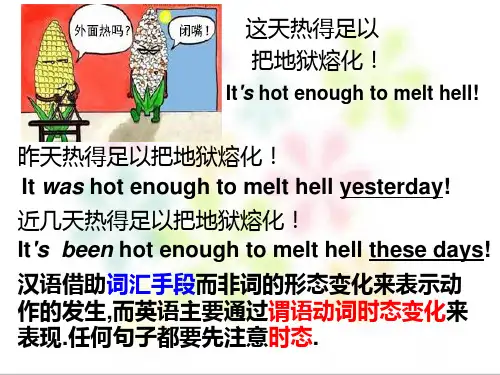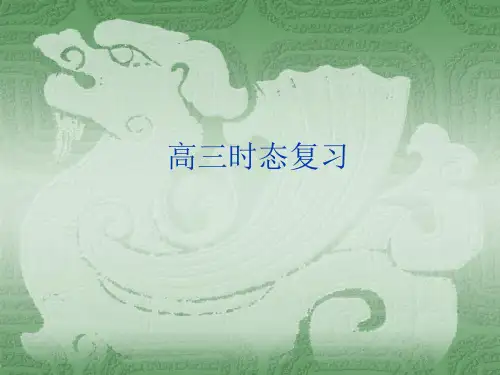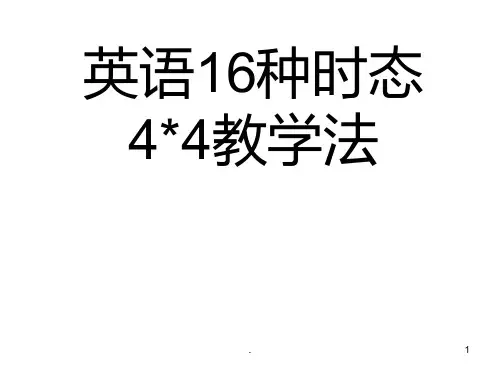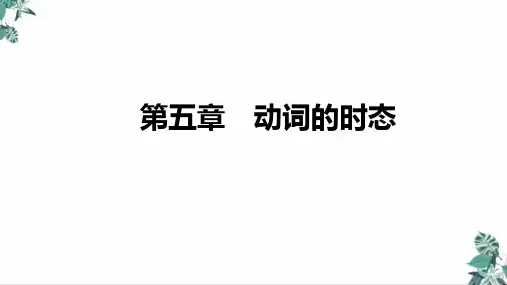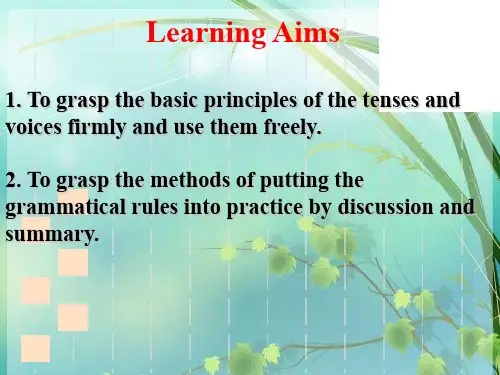- 1、下载文档前请自行甄别文档内容的完整性,平台不提供额外的编辑、内容补充、找答案等附加服务。
- 2、"仅部分预览"的文档,不可在线预览部分如存在完整性等问题,可反馈申请退款(可完整预览的文档不适用该条件!)。
- 3、如文档侵犯您的权益,请联系客服反馈,我们会尽快为您处理(人工客服工作时间:9:00-18:30)。
Now great changes have taken place in my hometown.
• The environment has become more beautiful.
• The river is clearer and the sky is bluer.
Many families have not only color TV sets, but also telephones, fridges, computers, and so on.
next…, soon, etc.
4.be about to do 表示“正要干什么…”, 表示即将发生的动作,不与表示将来的时间状语连用。
常与when 连用,when 此时意思: 就在这时,是并列连 词 构成句型: …be about to do …when….
I was about to leave when it rained.
2) he promised that he __________(join) us, but he hasn’t turned up at the party.
5. 现在进行时态( The Present Continuous Tense )
概念:表示现在或现阶段正在发生的动作
构成形式 : am/is/are+doing 常用时间状语 :
Tom: Our teacher, father.
时 现在
过去
将来 过去将来
体
一般 一般现在 一般过去 一般将来 一般过去
时
时
时
将来时
进行 完成
现在进行 过去进行
时
时
现在完成 过去完成 将来完成
时
时
时
完成进行 现在完成 过去完成 进行时 进行时
He works.
动词时态的掌握可以分为
He worked. He will work. He would work. He is working.
示,这每一种不同的形式就叫做时态。
高中英语
The Father and His Son
Father: You know, Tom, when Lincoln w__a_s(be) your age, hew__a_s(be) a very good pupil. In fact, hew_a_s_(be) the best pupil in his class.
3. A woman saw him crying and telling him told
to wait outside a shop.(2015全国II卷改错)
一般过去时的注意点:
1、当没有明显的时间状语时,描述几个相继发生 过的动作
I always got up too late , washed my face , had a quick breakfast and hurried to school .
He will have worked. He would have worked. He has been working. He had been working.
态基础上,就能比较容易 的掌握另外的几种较为复 杂的时态,还可以很容易
He will have been working. 理解这些时态所表达的意
4)people are living a happy life. 5)Maபைடு நூலகம்y people all have their own cars. 6)we will have a better life in the future.
时
态
一、定义: 在英语中,不同时间发生的 动作要用不同的动词形式来表
①If it is fine tomorrow ,we will go to the countryside.
如果明天不下雨,我们将去野营。
1)If itd_o_e_s_n_’t_r_a_in(rain) tomorrow, we’ll go on a picnic.
2)We _w_i_ll_b_e_g_in__ ( begin) our class as soon as the teacher _c_o_m_e_s_(come) 3)We don’t know if it __w__il_l _ra__in___(rain)
Many people all have their own cars
1)The houses were old and small.
2)People used to live in old buildings.
3)Now great changes have taken place
in my hometown.
now,listen,look, right now, these days, at this moment,etc
1)“What are they doing?” “They a_r_e_g_e_ttingready for the sports meeting.” (get)
minutes’ rest between two classes.
一般现在时的用法
2) 客观真理,客观存在,科学事实或表示格言或 警句。
①Knowledge __b_e_g_in_s__(begin )with practice.
② She said that the sea water__is__ (be) salty.
Tom: Yes, Father. I _k_n_o_w (know) that. But when he w__a_s_(be) your age, he_w_a_s_ (be) President of the United States.
Who Is the Laziest?
Father: Well, Tom, I asked your teacher today, and now I want to ask you a question. Who is the laziest person in your class?
Exercise
1)The radio says that it _____w__il_l be (be)
sunny tomorrow.
2)It is reported that a space station _w_i_ll_b__e_b_u__ilt
(built) on the moon in years to come.(2015安微卷改编)
常用时间状语 :
every day, always, usually, often, sometimes, on Sundays, three times a day , etc
Exercise
1. Who ___d_a__n_c_e_s__(dance) best in your class? 2. Students usually __h_a_v_e_____(have) ten
Exercise
1.I __f_o_u_n_d_____(find) my ruler in my
desk five minutes ago .
2.We looked up and ____s_a_w____(see) lots of birds __f_ly__in__g____(fly) over the trees.
1 一般现在时的用法
3)按火车、汽车、飞机等时刻表将要发生的事。 此时句中有时有将来的时间状语,但不用将来时 此时主主语是物:车,船,飞机等
The train leaves at three this afternoon.
4)在时间、条件、方式、让步状语从句中,用 一般现在时代替一般将时.(when,before,if,as soon as, unless…【主将从现】
4. 过去将来时态
过去将来时态用法:
1. 表示从过去某时看将要发生的动作或存在的 状态;
2. 用于宾语从句中,当主句中是过去时态时, 从句中的一般将来时就变成过去将来时。
He said that he would wait for us at the station. 他说他要在车站等我们。
1)At college, Barack Obama didn’t know that he _______(become) the first black president of America.
tomorrow.
If it ___r_a_in__s_ (rain) tomorrow, we’ll not go for a
picnic.
2. 一般过去时态(The Simple Past Tense)
概念: 表示过去某个时间发生的动
作或存在的状态
构成形式 : V+ed
常用时间状语 :
yesterday, just now, last …, in 1945, at that time; once; a few days ago; when, etc
两个部分,首先要熟练掌 握八种基本时态,即一般 现在时、现在进行时、一
He was working. He will be working. He would be working. He has worked. He had worked.
般过去时、过去进行时、 现在完成时、过去完成时、 一般将来时和过去将来时。 在熟练掌握这八种基本时
had + Vp.p have /has + Vp.p will have + Vp.p am /is / are + Ving was /were + Ving
1.一般现在时态( The Simple Present Tense)
